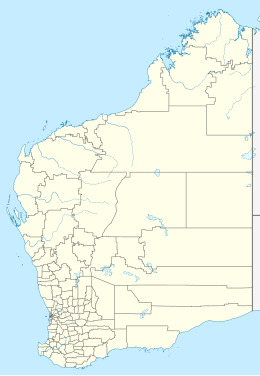Hidden Island
| Geography | |
|---|---|
| Coordinates | 16°14′35″S 123°28′57″E / 16.2431°S 123.4824°E |
| Area | 1,901 ha (4,700 acres) |
| Length | 8 km (5 mi) |
| Width | 5 km (3.1 mi) |
| Highest elevation | 135 m (443 ft) |
| Administration | |
Australia | |
| Demographics | |
| Population | 0 |
Hidden Island, known to the
traditional owners as Banggoon, is an uninhabited island located in the Kimberley region of Western Australia
.
It is situated in the western group of the
Bardi, it covers an area of about 1,901 hectares (4,697 acres). It has an irregular shape with a length of about 5 miles (8 km) running from north to south and is 3.25 miles (5 km) at its widest point.[2]
The highest point of the island has an elevation of 135 metres (443 ft), at the southern end. Another hill with a height of 97 metres (318 ft) is located at the northern end. The island is covered in low scrub and stunted gum trees.[2]
Hidden Island is separated from nearby Chambers Island by Whirlpool Passage. The passage is dangerous during peak tidal movement with a flow rate of over 10 knots (12 mph) and numerous 1 metre (3 ft) deep whirlpools.[3] It is separated from the mainland by a narrow channel.
Priority flora found on the area include Solanum leopoldense Symon.[1][4][5]
The
Unggarranggu[6]) peoples of the Worrorran languages group, whose name for the island is Banggoon.[7]
References
- ^ a b "Status Performance Assessment: Biodiversity conservation of Western Australian Islands" (PDF). Government of Western Australia. 1 April 2010. Archived from the original (PDF) on 14 March 2018. Retrieved 10 August 2014.
- ^ ISBN 9781577856559.
- ^ "Kimberley Coast Beach Camping Cruises". One Tide Charters. 2010. Retrieved 11 August 2014.
- ^ "Solanum leopoldense Symon". FloraBase: Western Australian Flora. 1 July 2003. Retrieved 10 November 2020.
- ^ "Species: Solanum leopoldense". Atlas of Living Australia. Retrieved 10 November 2020.
- ISBN 9781921666087.
- ^ T. Vigilante; et al. (2013). "Biodiversity values on selected Kimberley Islands, Australia" (PDF). Western Australian Museum. Retrieved 11 August 2014.

